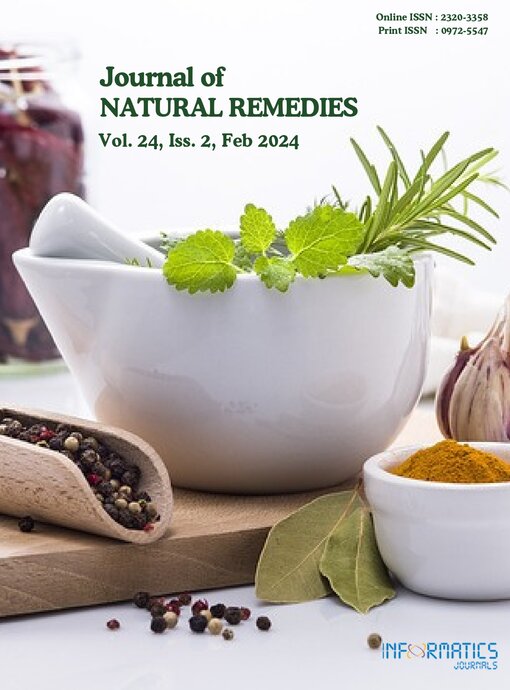Standardisation and Quality Control Parameters of Phalatrikadi Ghana Vati – An Ayurvedic Formulation
DOI:
https://doi.org/10.18311/jnr/2024/35126Keywords:
Ayurveda, Bhaishajya Kalpana, Phalatrikadi Ghan Vati, Phalatrikadi Kwatha, StandardisationAbstract
Drug standardisation, profiling, and quality control continue to be a challenge for Ayurvedic medicines due to their wide range of dosage forms. Different dosage forms like decoctions and powders result in non-compliance from the patient owing to their palatability or cumbersome methods of administration. The present study aims to pharmaceutically process a traditional decoction, Phalatrikadi Kwatha, and standardise it into tablet form, known as Phalatrikadi Ghana Vati (PGV). PGV was prepared and subjected to organoleptic, physicochemical, phytochemical analysis, and HPTLC analysis in an attempt to define its quality parameters and standardisation. Distinct fingerprints of Phalatrikadi Ghana Vati were obtained. Out of the eight components identified, the components with Rf values 0.08, 0.74, 0.65 and 0.83 were more predominant with more percent areas 9.65%, 14.91%, 18.02%, and 40.67%, respectively Quantitative physicochemical analysis revealed loss on drying as 1.33%, ash value as 4.53%, water-soluble extractive as 15.38%, alcohol extractive as 9.63% and pH as 5.1. The study also revealed the presence of alkaloids, glycosides, flavonoids, amino acids, and saponins. Preliminary profiling of PGV exhibited striking analytical characteristics. The physicochemical parameters were in the range of a standard tablet. The quantitative physicochemical parameters and HPTLC profile can be used as a reference standard for the quality control of Phalatrikadi Ghan Vati.
Downloads
Metrics
Downloads
Published
How to Cite
Issue
Section
License
Copyright (c) 2024 Piyush Chaudhary, Bharat Rathi, Neha Lamba, Anil Sharma, Renu Rathi (Author)

This work is licensed under a Creative Commons Attribution 4.0 International License.
Accepted 2023-11-30
Published 2024-02-01
References
World Health Organisation. Guidelines on safety monitoring of herbal medicines in pharmacovigilance systems [Internet]. Geneva: WHO; 2004 [cited 2022 Dec 13]. https://apps.who.int/iris/bitstream/ handle/10665/43034/9241592214_eng.pdf
Chaudhary P, Lamba N, Balian SK. Analytical study of Vanga bhasma. Int J Ayurvedic Med. 2014; 5(1):82-90. https://doi.org/10.7897/2277-4343.05484 DOI: https://doi.org/10.7897/2277-4343.05484
Chaudhary P, Rathi B, Rathi R, Tyagi V. Evaluation of the efficacy of Phalatrikadi Ghan vati in patients of non- alcoholic fatty liver disease through reverse pharmacology approach - study protocol. J Pharm Res Int. 2021; 16:88-96. https://doi.org/10.9734/jpri/2021/v33i59A34252 DOI: https://doi.org/10.9734/jpri/2021/v33i59A34252
Indradev Tripathi, Chakradatta, Vaidyaprabha hindi commentary, Pandurog Chikitsa. 1st ed. Varanasi: Chaukhamba Sanskrit Bhawan; 2012.
Baragi U, Baragi P, Vyas M, Shukla V. Standardisation and quality control parameters of Dashanga Kwatha ghana tablet: An Ayurvedic formulation. Int J Ayurveda Res. 2011; 2(1):42. https://doi.org/10.4103/0974-7788.83190 PMid: 21897642 PMCid: PMC3157108. DOI: https://doi.org/10.4103/0974-7788.83190
Sharma A, Baghel DS, Mittal A, Singh S. Standardisation and comparative study of Guduchi Churna, Guduchi Ghan vati and Guduchi Satwa. Think India Journal. 2019; 22(17):509-19.
Antony A, Shijikumar PS, Peter R. Formulation and evaluation of tablets from Navayasa churna by wet granulation method. Indian Res J Pharm Sci. 2018; 5(2):1522-38. https://doi.org/10.21276/irjps.2018.5.2.16 DOI: https://doi.org/10.21276/irjps.2018.5.2.16
Kulkarni U, Borgaonkar PA, Patil BS, Korwar PG. Formulation and development of fast disintegrating tablets containing fenugreek seed powder. Asian Journal of Pharmaceutical and Clinical Research. 2011; 4(1):87-9.
Anonymous. Ayurvedic pharmacopoeia of India. 1st Ed. Vol. Part 1, Vol. IX. Ghaziabad: Pharmacopoeia Commission for Indian Medicine and Homoeopathy; 2016. p. 113.
Remington, The Science and Practice of Pharmacy. 21st ed. Vol. 1. Wolters Kluwer, LW and W; 2010; p. 432.
Remya E, Mandip Goyal, Shukla VJ. Evaluation of pharmaceutical profile of Sharapunkhadi yoga - remedy for non-alcoholic fatty liver disease. Eur J Biomed Pharm Sci. 2018; 5(3):478-83.
Tiwari AK, Tripathi MK, Dwivedi N, Tiwari A, Tripathi SP, Ahirwar PK, et al. Standardisation of Dhanyapanchaka Kvatha Ghana vati - An ayurvedic formulation. Indian journal of traditional knowledge. 2018; 17(2):386-90.
Roop Khar, Vyas SP, Farhan J Ahmad, Gaurav K Jain, editors. Lachman/Leiberman’s The theory and practice of industrial pharmacy. 4th ed. CBS Publishers; 2017. p. 471.
Drug Absorption - Clinical pharmacology [Internet]. MSD Manual professional edition. (cited 2023 Jun 20). Available from: https://www.msdmanuals.com/en-in/professional/ clinical pharmacology/pharmacokinetics/drug-absorption
Vertzoni M, Augustijns P, Grimm M, Koziolek M, Lemmens G, Parrott N, et al. Impact of regional differences along the gastrointestinal tract of healthy adults on oral drug absorption: An UNGAP review. Eur J Pharm Sci. 2019; 134:153-75. https://doi.org/10.1016/j.ejps.2019.04.013 PMid:30991092 DOI: https://doi.org/10.1016/j.ejps.2019.04.013
Boxtel CJV, Santoso B, Edwards IR. Drug benefits and risks. Revised 2nd. IOS press Amsterdam and Uppsala monitoring centre, Sweden; 2008. p. 249.
Singh PK, Singh J, Medhi T, Kumar A. Phytochemical screening, quantification, FT-IR analysis, and in silico characterisation of potential bioactive compounds identified in HR-LC/MS analysis of the polyherbal formulation from northeast India. ACS Omega. 2022; 7(37):33067-78. https://doi.org/10.1021/acsomega.2c03117 PMid:36157760 PMCid: PMC9494667 DOI: https://doi.org/10.1021/acsomega.2c03117
Saraf AY, Saraf AA. HPTLC Fingerprinting: A tool for simplified analysis of phenolics in medicinal plants. Indian J Pharm Educ Res. 2020; 54(4):1098-103. https://doi.org/10.5530/ijper.54.4.205 DOI: https://doi.org/10.5530/ijper.54.4.205
Dawane V, Fulekar MH. High-Performance Thin Layer Chromatography (HPTLC) fingerprinting pattern of mangrove Avicennia marina. Int J Pharm Sci. 2017; 9(4):65. https://doi.org/10.22159/ijpps.2017v9i4.16480 DOI: https://doi.org/10.22159/ijpps.2017v9i4.16480

 Piyush Chaudhary
Piyush Chaudhary









 0.35
0.35 24
24 0.161
0.161